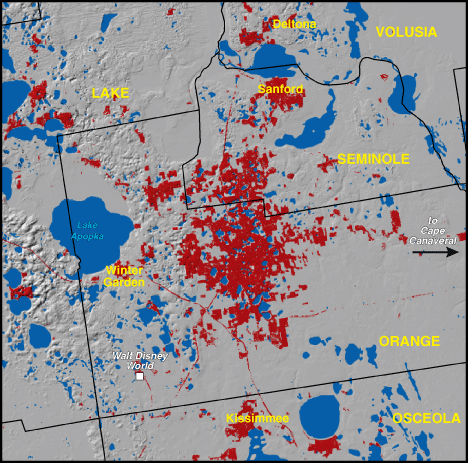Orlando, Florida 1973


|
1970 Population - 692,062
Includes Volusia, Lake, Seminole, Orange, and Osceola Counties. NOTE: portions of the above listed counties may not be visible on the map Red areas shown as developed land 115,900 acres (181 square miles) |
Orlando was founded in the 1870s amid the lakes and pines of central Florida. It became the trade center for a citrus-dominated agricultural region. Urban growth was stimulated during World War II by military training sites and defense production. This presence continued with the construction of the missile/space facility at nearby Cape Canaveral and the arrival of associated aerospace companies. An increasing number of retirees have also been attracted to the area since the 1950s. The Walt Disney World entertainment complex opened in 1971, and other theme parks followed. Orlando has been classified as a "tourist metropolis" and is a major destination for conventions and similar events. |
Orlando, Florida 1992

|
Population - 1,595,581
Includes Volusia, Lake, Seminole, Orange, and Osceola Counties. NOTE: portions of the above listed counties may not be visible on the map Red areas shown as developed land 297,600 acres (465 square miles) |
Orlando's rapid and sustained urban growth over the past several decades has resulted in a variety of problems. The surface water system of interconnected shallow lakes and slow-moving rivers is vulnerable to pollution. The metropolitan area has been characterized as a loose configuration of urban "bits" with no true urban core. The socioeconomic gulf between affluent professionals and lower paid workers appears to be widening, aggravating social concerns, such as a lack of affordable housing. Development in the region, however, has been channeled away from certain unique areas, such as extensive wetlands to the northwest and significant citrus farming to 1990 the southwest. |